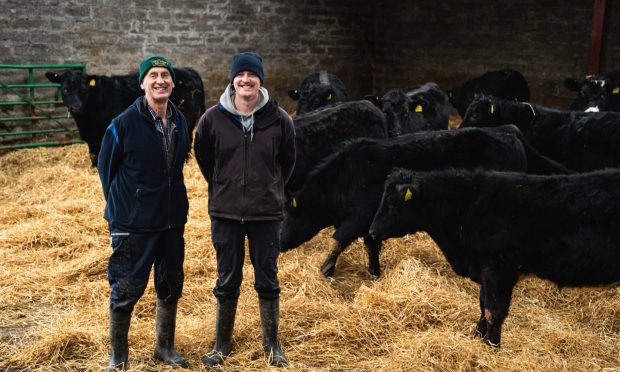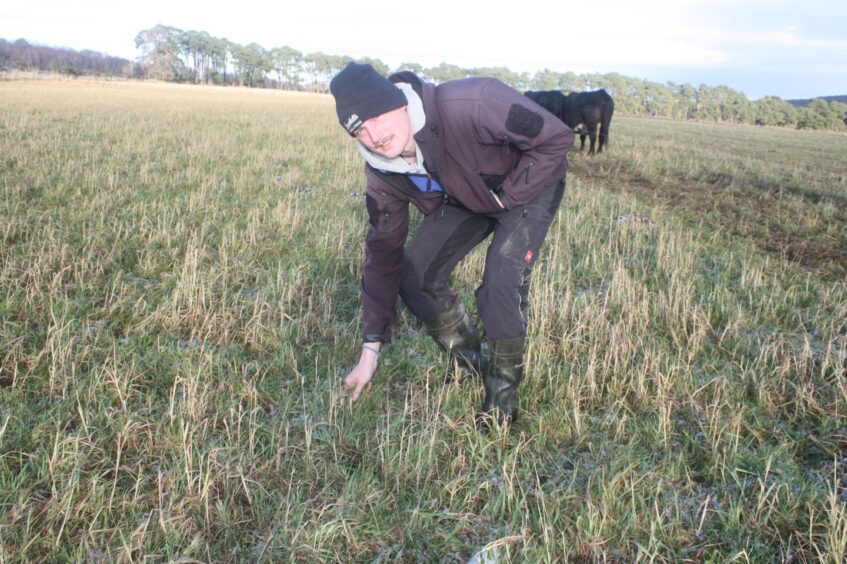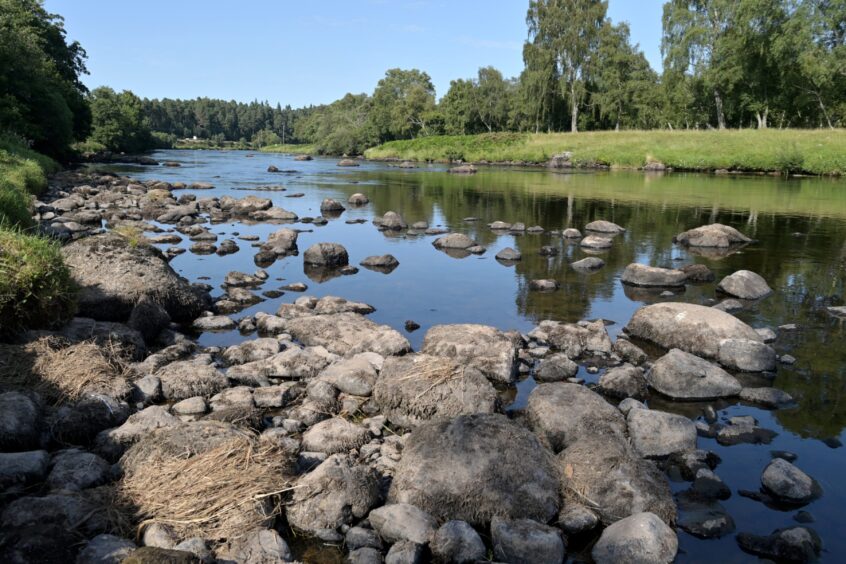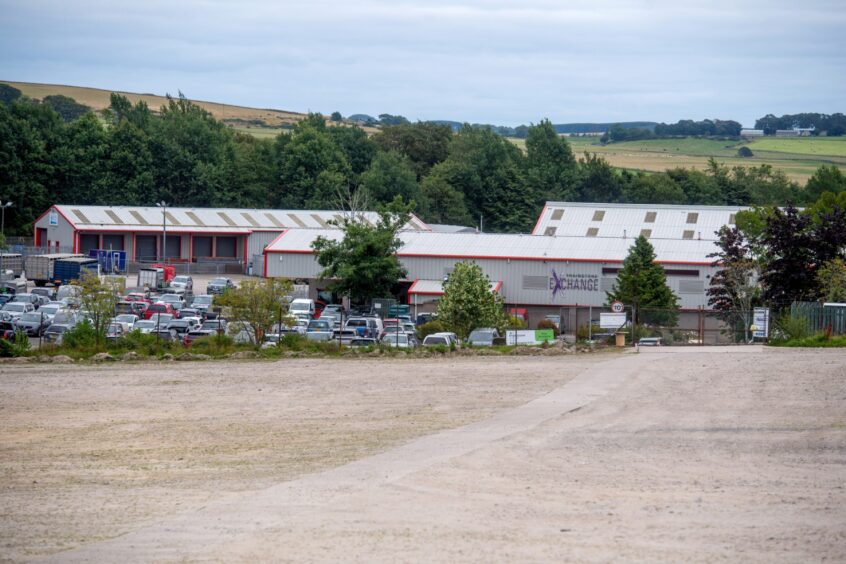The 2025 Royal Highland and Agricultural Society of Scotland President’s Initiative is providing a platform to show how Scottish farmers can achieve net-zero. Here, Ewan Pate looks at one Speyside business that has already taken practical steps towards reaching this goal.
Everything father and son Douglas and Duncan Miller do with their beef herd at Tullochgorum, near Grantown, is aimed at increasing efficiency and profitability.
But by every action they have also reduced the farm’s carbon footprint.
And through everyday management they are showing that moving towards net-zero need not be incompatible with increased profit margins.
Speyside farm’s ‘trigger’ came in 2019
This spring the Millers will be calving 130 cows and heifers, all Aberdeen-Angus but with a splash of Hereford in their breeding. All will have been wintered outside, with about two-thirds on a deferred grazing system that Duncan has refined in recent years.
The trigger came in 2019 with a change from autumn and spring calving to spring only.
It dawned on Duncan that as long as he used a suitable type of cow, it would thrive outside over winter. He also had a recently acquired field of grass which had not been cut or grazed over the summer.
Duncan’s deferred grazing system
His first tentative move was to see how well a group of cows would do on this deferred grazing. The results were sufficiently encouraging for him to develop a system which is now integral to the enterprise. Cows are run in batches of about 30 on fields which have had one cut of silage taken off in July and then been shut off for the rest of the season.
Deferred grazing starts in early November a few weeks before weaning, with the cows and calves grazing behind a single strand electric fence.
Fence is moved a little every day
Duncan then moves the fence forward a set distance every day, typically about four metres (13ft) depending on the size and shape of the field.
Every second day, he rolls out a bale of silage along the length of the grazing strip. He finds the cows prefer grass slightly earlier in the season and silage slightly better in the later winter month.
The calves are weaned for indoor housing later in November, by which time they have become used to eating silage. The cows will stay on deferred grazing until February/ March when they are housed briefly for calving.
“It all works well,” Duncan said, adding: “Strathspey has some of the most suitable land in Scotland for outwintering cows, which helps but in this system the cow is its own mixer wagon, silage contractor and dung spreader. That keeps the tractor hours very low and saves a lot of cost.
Breeding right type of cow is key
“It is important to breed the right type of cow. It must be capable of putting cover on its back during the summer, so it is relatively fat at the start of the deferred grazing period.”
The Millers’ first and second calvers also outwinter, but are fed silage and usually a forage crop on a more conventional system. None of the breeding herd is fed any cereals and creep feeding of calves has now been dropped.
Rotational grazing
A rotational grazing system has been adopted during the summer, moving the cows twice a week.
Very little fertiliser is used. The long-term grass mix supplied by Dods of Haddington consists mostly of rye grasses and white clover, but with some cocksfoot which can be a useful component later in the deferred grazing season.
Some of the fields at Tullochgorum have now had four years of being cut once for silage before being used for deferred grazing without any noticeable loss of sward quality.
It is a simple low carbon system but it relies on good forward planning.
Expert help
Duncan has enlisted the help of Stirling-based independent consultant Daniel Stout.
Using the Farmax management tool developed in New Zealand, the pair have been able to feed in every variable imaginable, such as cow numbers, fertiliser and feed usage, as well as required herd performance to help calculate the appropriate proportion of summer to winter grazing.
Tullochgorum, tenanted from the Seafield Estate, runs to 470 acres. Of these, 350ac are good grazing and the remainder rough grazing.
Speyside farm is real family affair
Duncan farms in partnership with his father and mother, Audrey.
The farm borders the River Spey, with 200 acres prone to occasional winter flooding and unsuitable for deferred grazing. Higher fields on either side of the Aviemore to Grantown road are free draining and cope well with the 38-inch average annual rainfall.
“Dad has invested heavily in lime and fencing over the years, so he has done the heavy lifting to make the farm suitable for what we are doing now,” Duncan added.
Apart from beef, the only other enterprise is sheep wintering. There are no cereals grown and no inversion tillage carried out, apart from ploughing, to sow barley, oats, peas and vetch as a nurse crop for grass reseeding.
Nitrogen fixing plants in the nurse crop are another plus point for reducing emissions.
Steer calves weighing 400-450kg (882-992lb) are sold as yearling stores, mostly at Thainstone. Heifers go back to grass for a second summer and those not kept for breeding are sold at 18 to 20 months.
The farm is a member of the Quality Meat Scotland Farm Assured Scheme.
Replacement heifer selection is rigorous, with only the offspring of cows which have conceived within two cycles considered. Heifers calve at two years old and are run with the bull for just six weeks, with any which have not settled rejoining the finishing group.
Cows run with the bull for nine weeks and any empties are culled. The aim is to be able to comply with the 410-day calving interval proposed for the new beef calf scheme and ensure the Millers are only breeding from the most fertile animals.
Future plans
The Breedr Cattle Management Scheme is used to record data such as calf weight, calving ease and speed to suckle.
There are plans to grow forage crops to reduce the already low use of cereals, and there is a biodiversity project under way with Cairngorms National Park.
In short, everything is being done to make the farm efficient and reduce carbon emissions without any of the measures being in conflict.
“We are not trying to offset our carbon emissions like other industries – we are trying to address the problem head on.”
Duncan said: “ Farming is in the front line of the effort to tackle the climate challenge.
“We are not trying to offset our carbon emissions like other industries – we are trying to address the problem head on. When managed correctly, ruminants can be part of the solution. They convert grass, a crop humans cannot eat, into a sustainable source of protein. With a better understanding of how grasslands store carbon, beef and sheep farming will, hopefully, receive the recognition it deserves for its role in sustainability.”




Conversation